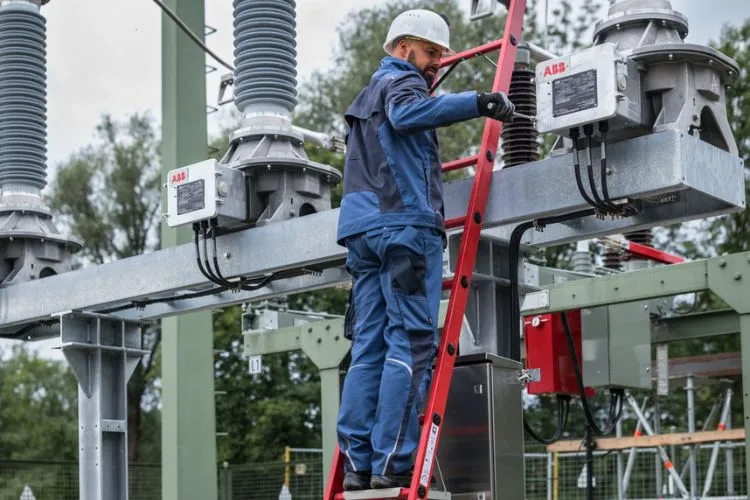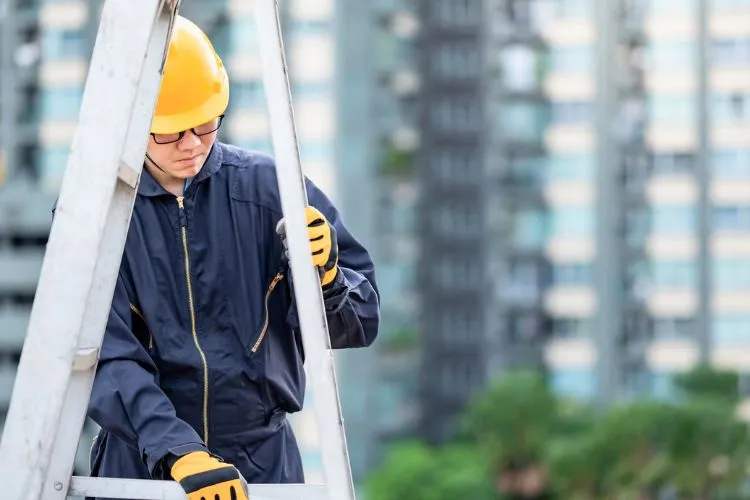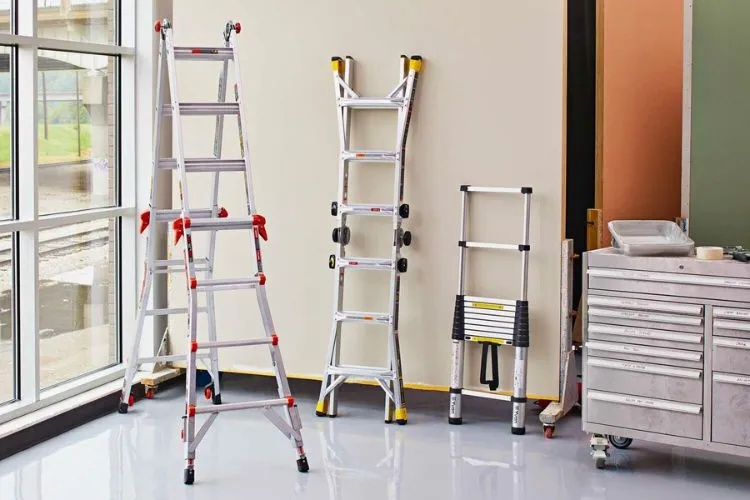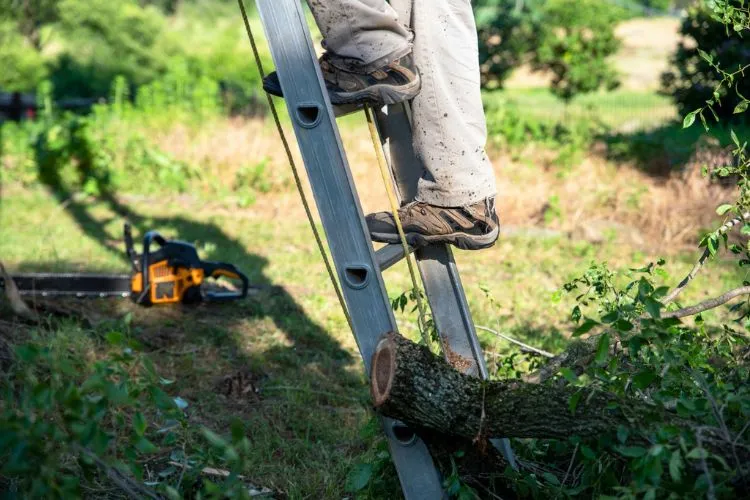Maintaining safety when using ladders near electrical hazards is paramount. Each year, numerous accidents involve ladders and electricity, some resulting in severe injuries or even fatalities.
This article navigates through essential practices to ensure on how to stay safe when using ladders near electricity.

How To Stay Safe When Using Ladders Near Electricity?
Working with or around electricity demands caution. Ladder-related accidents typically occur due to direct contact with electrical wires or conductive materials touching electrical sources. Electrocution and electrical burns are common risks.
Ladder materials play a significant role in these accidents. For instance, aluminum ladders, while lightweight and durable, conduct electricity, posing a higher risk near electrical sources compared to non-conductive materials like fiberglass.
Choosing the Right Ladder
Safety starts with selecting the appropriate ladder for the job. When working near electricity, a non-conductive fiberglass ladder is the safest choice, minimizing the risk of electrical conduction.
Checking the ladder’s specifications for electrical safety ratings should become a standard practice before use. These ratings ensure the ladder’s material and construction are suitable for working in environments where electrical hazards are present.
Pre-Use Inspection
A thorough inspection of the ladder before each use is crucial, especially in electrical work settings. Users should examine the ladder for structural damage, such as cracks or splits, ensure it is dry and clean of any contaminants that might conduct electricity, and check for signs of previous electrical damage.
Neglecting these checks could turn a safe ladder into a conductor of electrical currents.
Setting Up the Ladder Safely
Proper ladder setup is essential to maintain stability and reduce the risk of accidents. When setting up a ladder near electricity, ensure it is placed on stable ground, away from wet areas, and that it is extended and locked securely.

Keeping a safe distance from electrical sources, as outlined in safety guidelines, prevents unintended contacts. Utilizing barriers or signage can also help maintain this distance, especially in busy areas or near obscured electrical hazards.
Safe Practices While Using Ladders
While climbing or working on a ladder near electrical sources, adopting safe practices can make a significant difference. Always maintain three points of contact on the ladder to ensure stability.
Avoid reaching out too far from the ladder, as this could lead to falls or unintentional contact with electrical wires. Wearing the right personal protective equipment, such as rubber-insulated gloves and non-slip shoes, provides an additional layer of safety.
Emergency Procedures
Knowing what to do in case of an electrical accident can save lives. Do not attempt to move a person who is in contact with electricity. Turn off the power source, if possible, and call emergency services immediately.
Familiarizing oneself with basic first aid for electrical shock and burns can also be beneficial until professional medical help arrives.
Maintenance and Storage
Proper maintenance and storage of ladders are vital to preserving their non-conductive properties and structural integrity. Clean ladders regularly to remove dirt and contaminants.

Store them in a dry, protected area to prevent damage from environmental elements. Regular inspections and maintenance checks help identify potential issues before they pose a risk.
Legal and Compliance Issues
Adhering to legal standards and compliance requirements for ladder use near electricity is not only a matter of safety but also a legal obligation.
Regulations, such as those by the Occupational Safety and Health Administration (OSHA), delineate clear guidelines for ladder safety in environments where electrical hazards are present. Compliance helps avoid legal repercussions and ensures a safe working environment.
Training and Certification
Proper training is essential for workers using ladders near electrical hazards to ensure they understand risk factors and implement safety measures effectively.
Comprehensive training programs often cover ladder selection, inspection, handling, positioning, and emergency response protocols. Workers should also be educated on the limitations and capabilities of different ladder types.

Certification programs specific to electrical safety, such as those offered by OSHA or other accredited institutions, provide credentials that affirm an individual’s competency in electrical safety practices.
These certifications typically require participants to complete coursework and demonstrate proficiency in applying safety protocols in practical scenarios. Investing in such training and certification safeguards workers and bolsters a company’s commitment to safety.
Pro Tips
Conducting a risk assessment before starting work can identify potential electrical hazards in the area. This proactive approach allows for the implementation of safety measures before work begins.
Ongoing training and safety refreshers help keep safety practices front and center in the minds of those working with ladders near electricity.
Frequently Asked Questions (FAQs)
What types of ladders are safe to use near electricity?
Non-conductive fiberglass ladders are safest for use near electrical sources due to their resistance to electricity.
How far should a ladder be placed from power lines or electrical sources?
Safety guidelines recommend maintaining a minimum distance of 10 feet from overhead power lines, but this distance may vary based on voltage and local regulations.
Is it safe to use metal ladders if they have rubber feet?
While rubber feet provide stability, they do not prevent the ladder itself from conducting electricity. Non-conductive ladders are the safest option near electricity.
What should I do if my ladder contacts a live electrical wire?
Do not touch or attempt to move the ladder. Turn off the power source if safely possible and call emergency services immediately.
How often should ladders be inspected for electrical safety?
Ladders should be inspected before each use, with more thorough inspections scheduled regularly according to the manufacturer’s recommendations or when the ladder sustains damage.
Conclusion:
The use of ladders near electricity requires a heightened level of caution. By understanding electrical hazards, choosing the right ladder, performing pre-use inspections, and adhering to safe practices, risks can be significantly minimized.
Regular maintenance, awareness of emergency procedures, and compliance with legal regulations further enhance safety. Prioritizing these measures not only protects users but also promotes a culture of safety and responsibility.
Emphasizing safety when using ladders near electricity is paramount to preventing accidents. By applying the guidance outlined in this article, individuals can significantly reduce their risk of injury and create a safer working environment for themselves and those around them.


